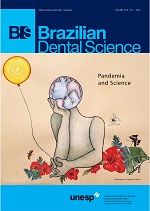Prevalence of Melanin Pigmentation in a Yemeni Population and its Relation to Some Risk Factors
DOI:
https://doi.org/10.14295/bds.2020.v23i2.1906Abstract
Objective: The present study aimed to explore the prevalence of melanin pigmentation in a sample of Yemeni population and its relation to some possible risk factors. Material and Methods: This crosssectional study was performed on 440 patients attending a private clinic. Printed questionnaires were introduced to the patients and a clinical examination was performed for each patient. The questionnaire included questions regarding demographic data, and questions regarding some common habits such as smoking, khat chewing and consuming of hot drinks. Melanin pigmentation was assessed regarding its presence, most affected areas and the numbers of affected quadrants. The data were managed and analyzed using SPSS software program. Descriptive statistics and inferential statistics were performed and the associations of melanin with risk factors were evaluated at P value < 0.05. Results: Four hundred and forty patients with mean age 29 ± 8.21 years were included in the study. Of them, 67.5% were fair-skinned, 26.8% were smokers, 48.2% were khat chewers and 33.6% were hot drinks consumers. The prevalence of melanin pigmentation was 62.7%, with class I represented 56.5% of cases. Males showed more prevalence (67.9%) of melanin pigmentation than females (57.7%) with no significant difference. Results also showed more prevalence of melanin pigmentation in patients > 25 years, and darkskinned patients. Regarding habits, smoking, khat chewing and hot drink consumption habits showed significant associations with melanin pigmentation. Whereas the association of khat chewing and hot drinks alone with melanin pigmentation showed no significant relationship with melanin pigmentation while, the merge effects of khat chewing and smoking habits together with melanin pigmentation showed significant relationship with melanin pigmentation. Conclusion: It can be concluded that Yemeni people had high prevalence of melanin pigmentation with more prevalence of CL I type. Males, patients > 25 years and dark-skinned patients showed more prevalence of melanin pigmentation. Smoking, khat chewing and hot drinks consuming habits had significant associations with melanin pigmentation.
KEYWORDS
Melanin; Yemeni; Smoking; Khat chewing; Risk.
Downloads
Downloads
Published
How to Cite
Issue
Section
License
Brazilian Dental Science uses the Creative Commons (CC-BY 4.0) license, thus preserving the integrity of articles in an open access environment. The journal allows the author to retain publishing rights without restrictions.
=================




























